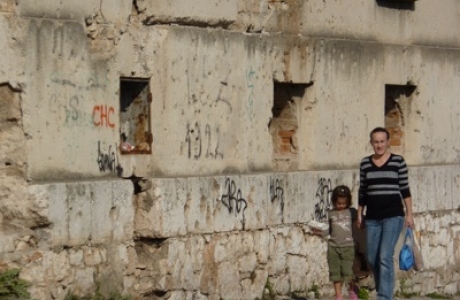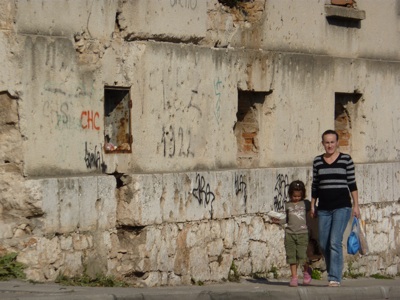
For decades, the balance of power between strong states was the central issue in discussions of international security—the Cold War, the rise of China, and peace in the Middle East as brokered by the dominant world powers.
But today it is so-called "fragile" states that are seen by many as posing equal, or potentially even greater, threats to global security. Fragile states run the spectrum from those that are struggling to keep a functional government in place to those that are failing in their ability to protect and provide for their populations.
US Ambassador to the United Nations Susan Rice emphasizes that instability from fragile states can fester and spill over to neighboring countries and create environments where extremists and criminals can operate and where terrorists can find safe heaven. She sees additional threats of disease pandemics and mass migration. Therefore, she says, the United States has a stake in the successful resolution of conflicts, even in parts of the world that may seem distant and far-flung to the average American.
More than a billion people across 60 nations are living in fragile or failing states. For them, the inability or unwillingness of their governments to protect people and provide basic social services means that large portions of the world's population are unable to pull themselves out of poverty, illiteracy, or gender inequality. So, the need to shore up fragile states is one that transcends security, and it has economic and moral ramifications as well.
But just as there has been a rising recognition of the risks that fragile states create, there has been an increase in international efforts to stabilize and build up—or rebuild—these nations. Today the UN Department of Peacekeeping has a record 120,000 personnel in 16 missions around the globe. Many more multinational efforts, often led by regional bodies such as the African Union or NATO, work alongside, or even independent from, the United Nations.
Four Case Studies
As part of our reporting project on fragile states, we filmed in four countries on four continents—all of which have been the target of large nation-building efforts with varying degrees of success. Our goal was to examine what has worked and what has not; what lessons could be learned for future efforts; and how the United States might be better able to support—and be supported by—such multilateral interventions.
The first story in the "Fragile States" series focused on peacekeeping efforts in the Democratic Republic of the Congo. It was the only in-field report to air on national American television during Secretary of State Clinton's visit to the country in 2009, and offered an inside look at the complexities of protecting civilians in one of the most dangerous parts of the world. Challenges to the UN mission there—the largest in the world—include a lack of equipment, the responsibility to patrol difficult terrain the size of eastern United States, and the necessity to partner with a national army that is almost as predatory on the population as the rebels they are meant to fight.
The series continued to look at East Timor as the fledgling nation celebrated the tenth anniversary of its independence from Indonesia last August. The vast efforts to rebuild the country have been referred to as a "test tube" for international intervention, and have provided lessons for other nation-building efforts around the world, even Afghanistan. Everything from a functioning army and police force to governing bodies, to schools and roads were needed, and plans had to be developed for the country to adequately manage its natural resources wealth. Success in East Timor is far from guaranteed, but this report offered Americans a better understanding of what it takes to stabilize a post-war country.
The series also examined how 15 years of peace and reconstruction in Bosnia have failed to dispel underlying instability stemming from ethnic divisions entrenched by civil war and segregated politics. Rising nationalism is now once again stoking tensions, threatening to undermine the peace agreement that ended the bloodshed there in 1995. Bosnia is currently facing its biggest crisis since the end of its brutal war, and some observers, even diplomat Richard Holbrooke who helped broker the Dayton Accords, fear a return to conflict. Yet this urgent situation, so relevant to the United States, has been almost completely overlooked by the American media.
Finally, the series wrapped up with an examination of the perpetually struggling country of Haiti and its "moment of hope" that was beginning to take shape in the year before the devastating earthquake hit. A confluence of political stability and security was allowing the tentative return of investors, especially those looking to expand Haiti's once thriving but now mostly mothballed garment industry. Whether Haiti could take advantage of this promising trend and finally pull itself out of failure was an open question. Now the country is facing challenges larger than could ever be foreseen.
Human Security Indicators
The "Fragile States" series also examined the very definition of what it means for a state to be secure. Louise Arbour, president of the International Crisis Group, suggests that analysts have historically looked at security in a very traditional and maybe too narrow way—with the demobilizing of belligerents, the reintegration of ex-combatants, and a very military approach to security.
Her suggestion is that instead we expand our assessment of state fragility to include other indicators of real human security; for example, whether or not girls are returning to school and women are safe in their communities or whether civil society is occupying some space. Arbour believes that by looking at these other types of indicators, we will have a better sense of whether this is a state that is ensuring security to its populations.
Resource:
Fragile States, Global Consequences, an event-in-a-box toolkit featuring a DVD helps viewers examine the global challenge of fragile states.









